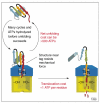ATP-dependent proteases of bacteria: recognition logic and operating principles
- PMID: 17074491
- PMCID: PMC2717004
- DOI: 10.1016/j.tibs.2006.10.006
ATP-dependent proteases of bacteria: recognition logic and operating principles
Abstract
ATP-powered AAA+ proteases degrade specific proteins in intracellular environments occupied by thousands of different proteins. These proteases operate as powerful molecular machines that unfold stable native proteins before degradation. Understanding how these enzymes choose the "right" protein substrates at the "right" time is key to understanding their biological function. Recently, proteomic approaches have identified numerous substrates for some bacterial enzymes and the sequence motifs responsible for recognition. Advances have also been made in elucidating the mechanism and impact of adaptor proteins in regulating substrate choice. Finally, recent biochemical dissection of the ATPase cycle and its coupling to protein unfolding has revealed fundamental operating principles of this important, ubiquitous family of molecular machines.
Figures



References
-
- Schmidt M, et al. Proteasome-associated proteins: regulation of a proteolytic machine. Biol. Chem. 2005;386:725–737. - PubMed
-
- Ito K, Akiyama Y. Cellular functions, mechanism of action, and regulation of FtsH protease. Annu. Rev. Microbiol. 2005;59:211–231. - PubMed
-
- Bukau B, et al. Molecular chaperones and protein quality control. Cell. 2006;125:443–451. - PubMed
Publication types
MeSH terms
Substances
Grants and funding
LinkOut - more resources
Full Text Sources
Other Literature Sources
Molecular Biology Databases

